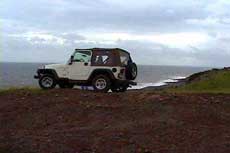One of the best ways to learn about Maui and experience their culture is to get some hands-on time with their arts & crafts scene. The indigenous arts of Maui range from dancing to spear throwing, and date back centuries. Other crafts on Maui, like quilting, are not as old, but rather symbolize the influence of the mainland on this island, beginning in the 1800s. Lauhala weaving is one centuries-old tradition in Maui, and incorporates the use of lau, which means "leaves" of the hala tree. The lau were braided and used for lot of things, such as wall thatch, mats, canoe sails, and clothing. YOu can see artisans today in Maui using lau to make handbags and bracelets. You can even learn to make your own lau craft.
From the days of old Hawaii to these modern times, one of the most versatile plants has been the ti (tee) plant.
 The many uses for its leaves through the ages are remarkable.
The many uses for its leaves through the ages are remarkable.Commonly used in Maui landscaping, ti plants have long, broad leaves of green, red, or maroon, sometimes in combination. Some varieties bear white or purple flowers or red berry-like fruit. Widely believed to bring good luck, ti is often planted at all four corners of a home to protect the family against misfortune.
To further ensure good luck and ward off evil spirits, ti is used in the standard practice of blessing a new home or even a place of business. In addition to reciting a prayer, or 'pule' (poolay), the Hawaiian officiant performs a ritual. He dips one end of the ti leaves into a Hawaiian koa wood bowl filled with water and red Hawaiian sea salt, then shakes the leaves to scatter the salt water to all corners. Few people on Maui risk moving into a new place without the benefit of a blessing ceremony.
Around the house, ti leaves are useful in cooking. A popular Hawaiian dish, laulau (lou lou), pork and butterfish wrapped first in taro leaves then packaged in wrapped ti leaves.
 Ti leaves are excellent for steaming food within. They hold in moisture and lend a distinctive flavor for an ono (delicious) meal.
Ti leaves are excellent for steaming food within. They hold in moisture and lend a distinctive flavor for an ono (delicious) meal.They are also used for imu (ee moo) cooking. Typically used for roasting a pig, the imu pit contains layers of rocks and banana leaves for heat distribution. Ti leaves cover the pit to hold in steam for a moist and tasty pork meal.
When serving food, Maui hosts use fresh ti leaves for table decorations, scattering tropical flowers on top. This looks particularly dramatic on a crisp, white tablecloth at Maui weddings. Ti leaves are typically placed on a serving platter under food, making any dish seem fancy.
Sources:
www. maui.org
http://www.mauitraditions.com/


 are reasonable, less so in tourist season, and the convenience is well worth it. If you prefer something different, many companies rent Harley Davidsons, Exotic Cars, and mopeds or scooters. There is now a public bus system on Maui, so if you're planning on staying around town, and prefer to sunbathe at the hotel and shop at the malls to touring the island and seeing the sights, then the bus is probably an economical way to go. Click on the links in the table below to read more about the various ways to get around Maui.
are reasonable, less so in tourist season, and the convenience is well worth it. If you prefer something different, many companies rent Harley Davidsons, Exotic Cars, and mopeds or scooters. There is now a public bus system on Maui, so if you're planning on staying around town, and prefer to sunbathe at the hotel and shop at the malls to touring the island and seeing the sights, then the bus is probably an economical way to go. Click on the links in the table below to read more about the various ways to get around Maui.
 The free Wailea Village Shuttle runs along the Kaanapali strip about every half hour 9am-6pm, stopping at all major resorts, the golf course, and the Whaler's Village shopping complex. Ask at your hotel desk for schedules. The Lahaina Express shuttle runs from 9am-10pm, connecting various stops in Lahaina to Kaanapali. The major pickup point in Lahaina is at the rear of the Wharf Cinema Center along Front Street.
The free Wailea Village Shuttle runs along the Kaanapali strip about every half hour 9am-6pm, stopping at all major resorts, the golf course, and the Whaler's Village shopping complex. Ask at your hotel desk for schedules. The Lahaina Express shuttle runs from 9am-10pm, connecting various stops in Lahaina to Kaanapali. The major pickup point in Lahaina is at the rear of the Wharf Cinema Center along Front Street. 














